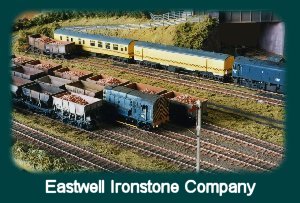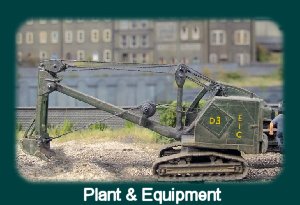*********************************************************************************************************************************************
JANUARY 2023 UPDATE
*********************************************************************************************************************************************

MIKE WHITCHURCH

The new pointwork for the double junction has been completed, just needs gapping and the existing
under baseboard wiring re-jigging to suit the new configuration, a job for after Christmas. Iím
rather impressed with the kink, Iím sure I didnít put it there deliberately!

Whilst there are many changes afoot, I didnít want to throw the baby out with the bath water
and I'm trying to make use of as much of the original layouts bits and pieces as possible to
maintain the character of Wibdenshaw.

One such item is the signal box, which. as it now controls a station throat I thought needed to
be in a more prominent position, and as the goods yard headshunt is no longer needed these
platforms can be cut back to align with the existing ones, and by so doing gives a nice central
location for the box.

In the past Iíd always thought that there was a missing girder bridge when seeing the layout at
exhibitions, so I decided to adaptobodge an old Airfix kit utilising some Central Valley framing
as well, and luckily the abutments were exactly the right distance apart, so Iím assuming it was
on the cards once upon a time, this is the state of play with things temporarily in place.

I would love to have the bridge on itís own loop, but there isnít room unless I get really
creative and take it outside through the terrace door, but there will at least be some form
of shuttle service going across it.
*********************************************************************************************************************************************

PETE JOHNSON

It turned out even the Dia 1/200 van convo wasnít without problems as the BR diagram book
has the incorrect roof profile, which Parkside seem to have reproduced in their kit of the
Dia 1/230. With the roof profile amended to the flatter LMS style (thanks JSW) the model
is pictured ready for weathering.

The completed van, B750081, has been finished to a Paul Bartlett photograph from the 1970s.

Another new type for the Canada Street wagon fleet is this Dia 1/042 highfit. The kit conversion
has added the two steel channel sections used in the ends of the 249 wagons built to this
diagram. The model has then been weathered to a typical early 1970s appearance for the type.
*********************************************************************************************************************************************

KARL CROWTHER

Firstly, a Happy New Year to one and all! The festive period has seen a diversion into
some scenic modelling, at long last! The plan is to get made the three bridge structures
that mark the exit/entry points at the various scenic breaks. Perusal of likely subjects
on the Furness system suggested that anything spanning more than two tracks (as are two
of mine) would have a girder-based construction. To build them Iíve basically used the
same techniques as those that were developed quite successfully on Hebble Vale.
Basically, Wills (Peco) materials Ė namely ĎVari-girderí Bridge Spans and the Coarse
Stone sheets. This first one illustrated is that for Kentside and being Ďsquare oní to
the tracks, was the easier to proportion Ė still with some detail to add at this stage.

The girder sections as they come were too deep for my subjects, so they were assembled
onto a backing piece of 60-thou styrene of the required depth. Once this has all dried,
the work was turned over and a Stanley knife used to cut away the redundant lower part
of the girders. The flange along the edge was re-made with a length of 15 x 80 thou
styrene strip, while the rivet strips were re-fashioned using some etchings done by
Mainly Trains (via Wizard Models), which were found to be just about perfect for the
job. Then it was onto making up the various abutments and wing walls and re-modelling
the stonework as necessary by scribing new joint lines and use of Milliput filler as
was outlined in MRJ 247. This second effort is for the entrance to the Kendal station
scene and as can be seen, is on a skew, so was a bit more challenging to get the required angles.

Here we see the Kentside overbridge being checked for its position on the layout, but most
prominent is an addition to the loco fleet, namely one of the new Bachmann Class 47s.
Iíve re-numbered it (using Railtec Transfers) as a class member delivered new to Holbeck
in 1964 and which was being run in on Leeds-Morecambe turns at this time Ė so all the
excuse that was needed! Iíve also changed the 4-character code to reflect those workings
(2M71 and 2N71), and added a 55A shedplate and makerís plate (Railtec 3D prints). Itís
an extremely well detailed model and was dead easy to convert to EM.

Again at Kentside D1571 departing the down platform with a Leeds City-Kendal working.
This particular version of the model features the early pattern radiator louvres which
are accurate for the loco at this date. Iíve done a very basic weathering, awaiting the
summer when I can get the airbrush out to complete the job.

And now arriving at Kendal Castle. The loco comes with a pair of speakers factory-fitted
so all I needed to do was plug in a Zimo/Digitrains Plux22 sound decoder. All dead easy
for a change! Itís emerging from under the skew bridge (minus wing walls at present).

I found it easier to dismantle the bogies to fit the new wheels, for which I used some
Ultrascales I had in stock. The wheels are mounted on plain 2mm axles, running in square
faced bearings that fit into slots in the drive units. The original wheels were pulled
off and the gear tapped out by resting the axle between the jaws of a vice. Having
knurled the centre of the new axles with the edge of a file, the drive gears could then
be fitted, followed by the square bearings and then some spacing washers. And look at
the neat plugs provided to connect the pickups to the modelís circuit board.

Here are the wheelsets re-fitted into a drive unit, ready for the sideframe moulding to be
clipped back into place (not forgetting the two central retaining screws Ė their holes
just visible in the photo). However, before doing this you need to thin down the brake
pull-rods that lie just inboard of the wheels or they will otherwise catch on these
fittings; there was no need to cut back any of the brake blocks. Then with the bogie
sideframes re-fitted, the pickup springs need to be adjusted slightly to be in good contact
with the rear of the wheel flanges. About as easy a conversion as you could hope for, really.
*********************************************************************************************************************************************

STEVE CARTER

With progress on the Hudswell stymied by Royal Mail stalling on delivery of some ordered
0.6mm drill bits then the meagre amount of modelling time has seen a sorting out of
previous uncompleted projects with some being consigned to the scrap heap whilst others,
which with a little bit of effort, could be completed without too much effort. First up
is a modified Parkside PC 35 kit depicting a LNER Conflat S to Diagram 104 in combination
with a scratchbuilt LMS Diagram 64 'B' type container from the series B1868M - B2287M.
Not many big four containers lasted in traffic by the early 1960s, but being built late
(1941-44) helped the design last in use until the mid 60s.

The LMS had a number of D1819 Calf Vans based upon Midland Railway practice with some in
later (BR?) days dedicated to carrying fruit traffic. Falcon Brass at one time did an
etched kit (WK212) so one was duly sourced and heavily re-worked to correct a number of errors.

A Chivers Finelines RC416 kit build representing a LNER D120 'BYP' Passenger Brake Van. The
kit does go together very well but seemed a little at odds with pictures of the vehicles,
mainly in the vicinity of the top light windows. A little reworking exercise has been carried
out whilst the original long fitted solebar footboard has been replaced with separate brass
steps as per an illustration of E70217E in the Bradford Barton 'BR General Parcels Rolling
Stock - A Pictorial Survey' book by Dave Larkin.

One project to benefit from experience gained with the Hudswell shunter will be a
long-stalled Judith Edge LMS 'Jackshaft' 0-6-0 DE Shunter from the first batch numbered
12003 - 12022. This was almost completed but ran aground on the fact of how to make the
Jackshaft axle / gearbox casing removable in case of problems. A similar approach to that
of the Hudswell will be carried out whilst replacement of original fitted Gibson wheel
sets with Markits ones will hopefully banish quartering problems.
*********************************************************************************************************************************************

STEVE HARROD

With winter fully in our midst, I have had time to think about what I am going to model over
this period. Both my Gauge 1 (1:32 scale) locomotives D819 and D6310 are waiting for the
warmer weather for the top coat paint to be applied. I started converting a Dapol D6320
into 6323 (as it had become by 1971) for my Newton Abbot works yard diorama. After separating
the body from the chassis and removing all the wiring for the cab and tail lights (I loath
those bright lights), I removed all the glazing from the cabs and headcode
boxes in preparation for making my own new glazing.

I then started attacking the inaccurate cab detail, so lots of cutting, which has left me with
a basic plasticard cab which I can add everything to.

I have now made both driver and secondmans front consuls, I just need to source 2 NBL diamonds
for above the connecting door and adding the driver seats and then it's all complete. Showing
the rebuilt cab which I think makes a huge difference, even in its embryonic state.

I've also removed the cover plates from the old air horn grill, as 6323 had a front end prang
and ended up with later style air horn pockets.

Some modification of the bogie is required for the EM conversion. The first image shows the
marked out area that requires filing back to accomodate the wheels on the wider axle. The
second image shows the completed area of the bogie filed out, and the third image shows how
much has been removed in comparison.
*********************************************************************************************************************************************

KIER HARDY

Progress on the Class 125 has been slow during the last month, but the bodies have now
been finished with recently applied transfers such as the orange star coupling codes,
no smoking triangles and destination blinds. Despite this, there has been a fair bit of
time spent on layout maintenance, track cleaning and general housekeeping.

Various video clips from running sessions over the last 12 months have been uploaded to
Youtube, as well as some new footage taken during layout maintenance. I've also taken
the opportunity to practice some of my video editing skills (still a long way to go yet)
and adding subtle low volume archive sound recordings. Please click on the above
image to view the latest videos.
Here's wishing everyone all the best for 2023.
*********************************************************************************************************************************************





































